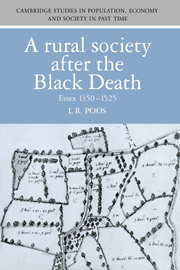Book contents
- Frontmatter
- Contents
- List of figures
- List of tables
- Preface
- Abbreviations
- Part I Reflections on a transitional era
- Part II ‘Country-dwellers, common folk and craftsmen’
- 1 People, land and occupations
- 2 Geography of a local economy
- 3 The rural cloth industry
- 4 Houses
- Part III ‘The total sum of all persons’
- Part IV ‘While it is so forward between us’
- Part V ‘She came that day seeking service’
- Part VI ‘Beware of such holy men’
- Part VII Synthesis
- Bibliography
- Index
- Cambridge Studies in Population, Economy and Society in Past Time 18
4 - Houses
Published online by Cambridge University Press: 14 September 2009
- Frontmatter
- Contents
- List of figures
- List of tables
- Preface
- Abbreviations
- Part I Reflections on a transitional era
- Part II ‘Country-dwellers, common folk and craftsmen’
- 1 People, land and occupations
- 2 Geography of a local economy
- 3 The rural cloth industry
- 4 Houses
- Part III ‘The total sum of all persons’
- Part IV ‘While it is so forward between us’
- Part V ‘She came that day seeking service’
- Part VI ‘Beware of such holy men’
- Part VII Synthesis
- Bibliography
- Index
- Cambridge Studies in Population, Economy and Society in Past Time 18
Summary
The houses in which rural people dwelt at the end of the middle ages, and the other buildings that they constructed and used, shed some unexpected light upon a number of aspects of the society of their inhabitants. In the tangible structures within which these people passed much of their lives, economic change intersected with social structures. Comparative levels of construction expense, complexity and sophistication reflected living standards and economic stratification, while household arrangements meshed with physical spaces. In short, the various permutations of housing in the district embodied both the layered economic and social strata and the co-resident units of local people's lives.
In Essex during the later fourteenth and fifteenth centuries, the houses of the better-off in rural society gradually evolved more numerous and varied rooms, serving to underscore in a very tangible manner the gulf in modes of life between wealthier agriculturalists and poorer labourers. Yet it has been only relatively recently that historians have combined archaeological and documentary evidence to produce a clearer picture of the physical structures of medieval rural houses from social strata below the gentry.
Evidence for the century or so after 1350 is especially full for England as a whole. In this period manorial lords, facing declining rent-rolls and concerned by the physical deterioration of their customary tenements, registered their anxieties in the manorial-court records in the form of constant orders to their tenants to repair houses and other buildings, and also in recorded agreements with new tenants assuming holdings to undertake substantial repairs or rebuilding, at times with the lord contributing materials.
- Type
- Chapter
- Information
- A Rural Society after the Black DeathEssex 1350–1525, pp. 73 - 88Publisher: Cambridge University PressPrint publication year: 1991



